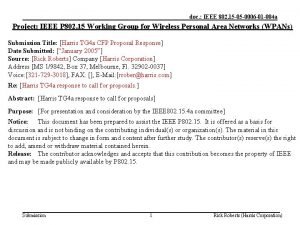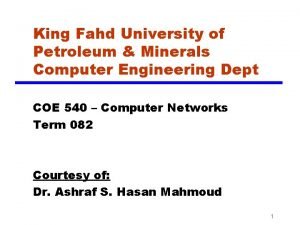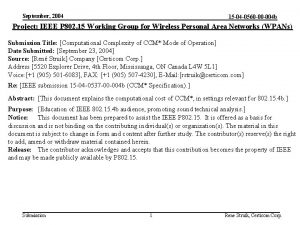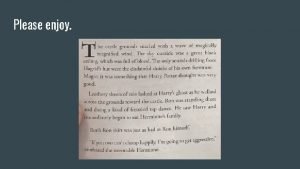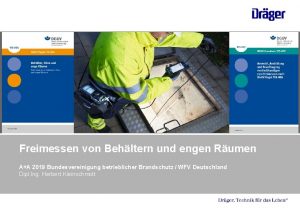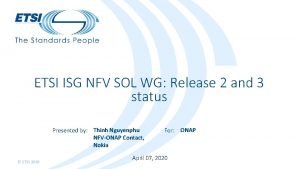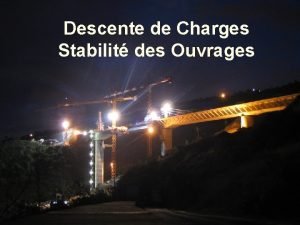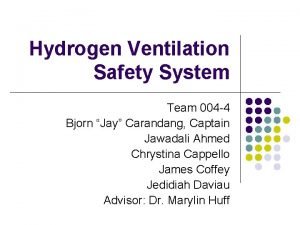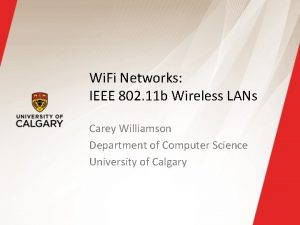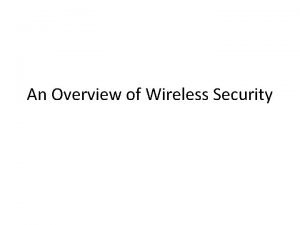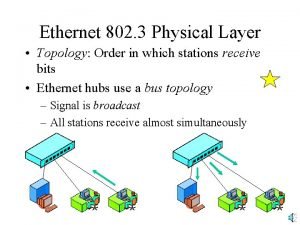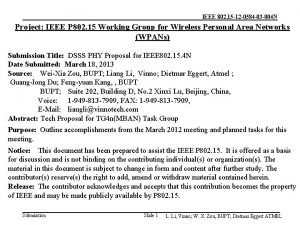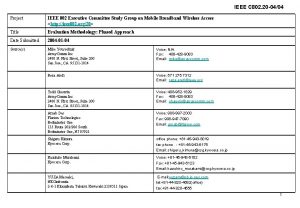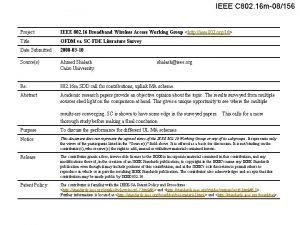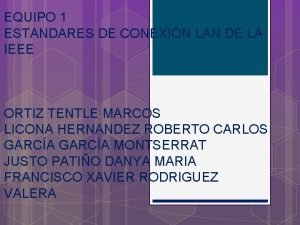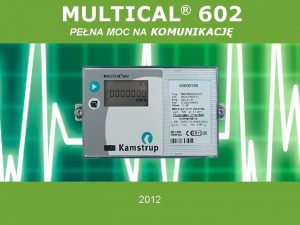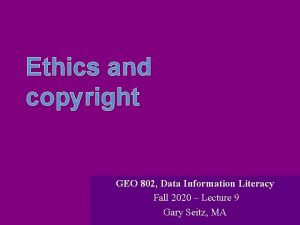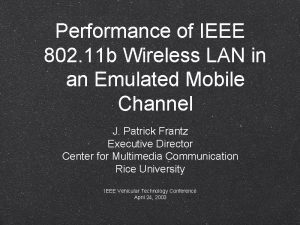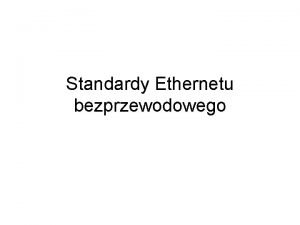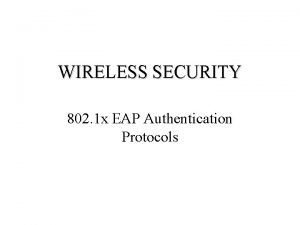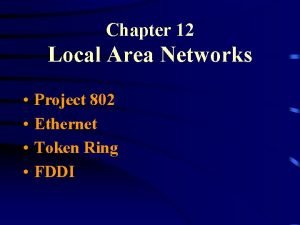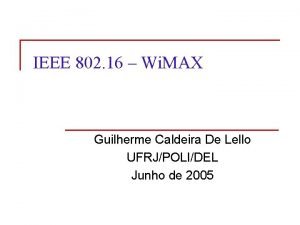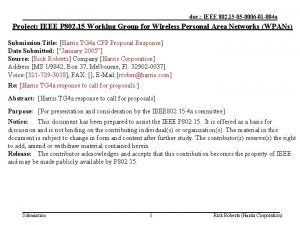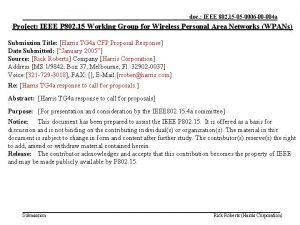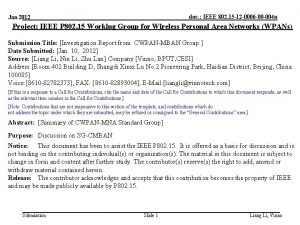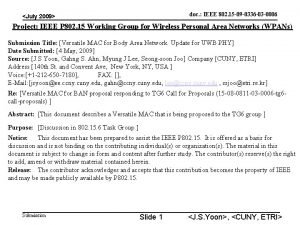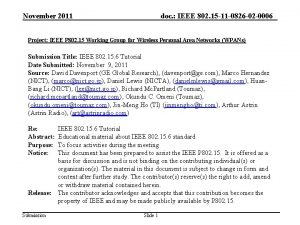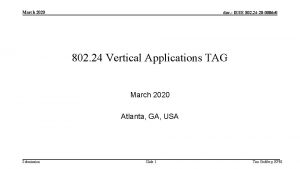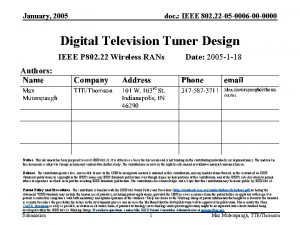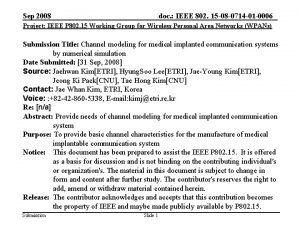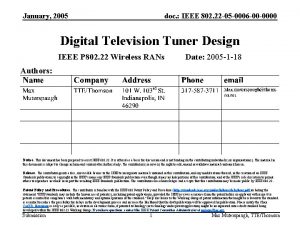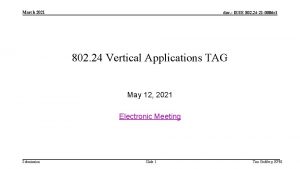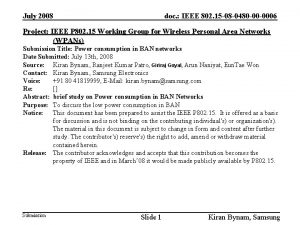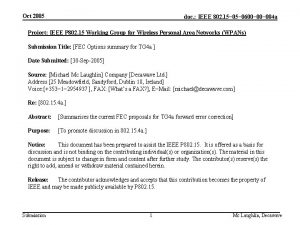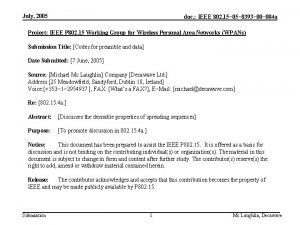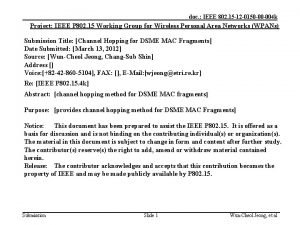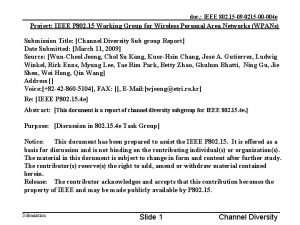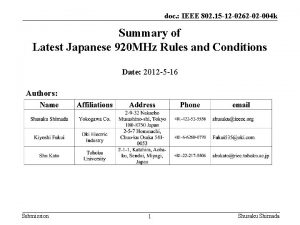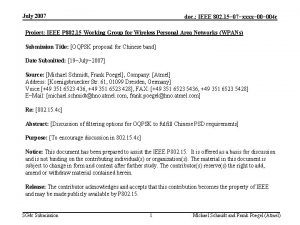doc IEEE 802 15 05 0006 00 004




































- Slides: 36

doc. : IEEE 802. 15 -05 -0006 -00 -004 a Project: IEEE P 802. 15 Working Group for Wireless Personal Area Networks (WPANs) Submission Title: [Harris TG 4 a CFP Proposal Response] Date Submitted: [“January 2005”] Source: [Rick Roberts] Company [Harris Corporation] Address [MS 1/9842, Box 37, Melbourne, Fl. 32902 0037] Voice: [321 729 3018], FAX: [], E Mail: [rrober@harris. com] Re: [Harris TG 4 a response to call for proposals. ] Abstract: [Harris TG 4 a response to call for proposals] Purpose: [For presentation and consideration by the IEEE 802. 15. 4 a committee] Notice: This document has been prepared to assist the IEEE P 802. 15. It is offered as a basis for discussion and is not binding on the contributing individual(s) or organization(s). The material in this document is subject to change in form and content after further study. The contributor(s) reserve(s) the right to add, amend or withdraw material contained herein. Release: The contributor acknowledges and accepts that this contribution becomes the property of IEEE and may be made publicly available by P 802. 15. Submission Rick Roberts (Harris Corporation)

doc. : IEEE 802. 15 -05 -0006 -00 -004 a Hybrid UWB/UNB Communications with Ranging Four Classes of Devices Class 1 – Low Complexity UWB for Communications with Ranging Class 2 – Backwards Compatible UWB with RFI Protection Class 3 – UWB/UNB with propagated node into GPS denied areas Class 4 – High Precision UWB for Ranging with Communications Submission Rick Roberts (Harris Corporation)

Class 1 UWB Communications with Ranging apartment 1 doc. : IEEE 802. 15 -05 -0006 -00 -004 a apartment 2 wireless thermostat AC AC Range Assisted Addressing Submission Rick Roberts (Harris Corporation)

Class 2 RFI Protected UWB Communications with Ranging doc. : IEEE 802. 15 -05 -0006 -00 -004 a Mobile Meter Reader Example GPS Equipped Truck Synthetic Triangulation Allows Precise Localization Submission Rick Roberts (Harris Corporation)

Class 3 UWB/UNB with propagated node into GPS denied areas doc. : IEEE 802. 15 -05 -0006 -00 -004 a propagated node into GPS denied area Public Safety Application UWB 20 m 50 m NFER 20 m Back Channel Out-of-scope (non-ranging) 30 m 802. 11 command post Submission Rick Roberts (Harris Corporation)

doc. : IEEE 802. 15 -05 -0006 -00 -004 a Mandatory UWB PHY Submission Rick Roberts (Harris Corporation)

Frequency Plan doc. : IEEE 802. 15 -05 -0006 -00 -004 a • Direct Sequence Spread Spectrum • -3 d. B Bandwidth (each band): 666. 7 MHz • Center Frequencies: Every 250 MHz (3. 6 GHz to 10. 1 GHz) 26 possible overlapping bands 3. 6 GHz 10. 1 GHz 3. 1 GHz 10. 6 GHz • Pulse Response: Root Raised Cosine, 25% Excess Bandwidth Fc(-3 d. B)=333. 3 MHz Fc +250 Noise Bandwidth (NBW) = 666. 6 MHz +333. 3 +416. 6 Submission Rick Roberts (Harris Corporation)

doc. : IEEE 802. 15 -05 -0006 -00 -004 a Advantages of Multiple frequency bands • Allows coarse spectral shaping for ingress/egress RFI avoidance • Allows multi-user separation by frequency channels • Allows implementation of lower frequency bands in today’s CMOS interference 3. 6 GHz 3. 1 GHz Interference avoided by skipping a frequency band Submission Rick Roberts (Harris Corporation)

doc. : IEEE 802. 15 -05 -0006 -00 -004 a Narrower Bandwidth, Spectrally Shaped UWB, Offers Advant • Spectral Shaping Results in more NBW which means more TX power • 25% Excess BW, Raised Cosine Pulse • -10 d. B bandwidth: 708 MHz • NBW: 667 MHz • Gaussian Pulse • -10 d. B bandwidth: 708 MHz • NBW: ~388 MHz • Raised Cosine Pulse Power Advantage: ~2. 35 d. B • More power, better controlled spectrum • Wider Wavelets offer implementation advantage • Less complexity if a RAKE is deployed • 666. 6 MHz of bandwidth still offers good multipath resolution Submission Rick Roberts (Harris Corporation)

doc. : IEEE 802. 15 -05 -0006 -00 -004 a Spectral Shaping within a frequency channel • “delay and add” notch formation • delay may be either a delay line or second impulse generator f f t 0 Submission t 1 Rick Roberts (Harris Corporation)

doc. : IEEE 802. 15 -05 -0006 -00 -004 a CDMA spread spectrum within each frequency channel • Chipping rate 666. 6 Mcps, 25% root raised cosine, Nyquist filtering • Bit Rate (Rb) options (1 bit per symbol) • Coherent: 1 Mbps, 500 Kbps, 250 Kbps, 125 Kbps • Non-Coherent: 62. 5 Kbps • Symbol Duration >> Delay Spread (shouldn’t need DFE) • Number of chips per bit • 1 Mbps: 666 • 500 kbps: 1332 • 250 kbps: 2664 • 125 kbps: 5328 • 62. 5 Kbps: 10656 • Actual codewords are TBD (ternary symbols: +1, -1, 0) • Processing gain (PG): 28. 2 d. B to 40. 3 d. B • PG = 10*log 10(NBW/Rb) = 10*log 10(666. 6 e 6/Rb) Submission Rick Roberts (Harris Corporation)

doc. : IEEE 802. 15 -05 -0006 -00 -004 a Advantages of high chipping rate • Minimizes the time waveform peak to average ratio • Each individual chip has low amplitude (integrated in the receiver) • Ternary codes: number of active chips per symbol is TBD • Enables high degree of integration on low voltage CMOS • Large code space allows selection of a number of good codes • Ternary codes are best for low cross-correlation • Time hopping codes are a possibility • Having a large number of codes allows code hopping multiple access Submission Rick Roberts (Harris Corporation)

doc. : IEEE 802. 15 -05 -0006 -00 -004 a Peak-to-Average: high chip rate vs. low chip rate Low Chip Rate Peak High Chip Rate Peak • For Equal TX Output, low chipping rate has a higher peak power and the high chipping rate has a lower peak power • Lower peak power is easier to integrate into low voltage semiconductor process Submission Rick Roberts (Harris Corporation)

doc. : IEEE 802. 15 -05 -0006 -00 -004 a SOP (Simultaneous Operating Piconets) Two Methods to Accommodate SOP: 1. Multiple Frequency Channels (FDMA) 2. Within a frequency channel, use code division multiple access (CDMA) • Each of possible 4 CDMA piconets uses a chipping rate offset • Chipping rate offset prevents static cross correlation degradation Submission Rick Roberts (Harris Corporation)

doc. : IEEE 802. 15 -05 -0006 -00 -004 a Acquisition Preamble • Acquisition is strictly a function of SNR, not bit rate or symbol rate • For a given signal strength, the longer the preamble (observation time) the more robust the acquisition (more integration results in higher SNR) • Three preamble lengths: • Mandatory medium length preamble for normal use • Optional short preamble for higher mobility, high SNR scenarios • Optional long preamble for long range, low SNR scenarios • Acquisition can be either a code search (traditional spread spectrum) - or – • If SNR is high enough and channel is benign enough, use of a squaring loop enables cyclo-stationary assisted acquisition (recover carrier/clock frequency from collapsed spectrum – very useful for 62. 5 Kbps noncoherent OOK) Submission Rick Roberts (Harris Corporation)

doc. : IEEE 802. 15 -05 -0006 -00 -004 a Two Modulation, Demodulation Modes 1. Coherent demodulation at Rb = 125 Kbps and higher Data Source Coded Wavelets Analog SP Digital SP Coded Wavelets 2. OOK (on-off keying) Non-Coherent demodulation at Rb = 62. 5 Kbps Data Source ( )2 Analog SP Digital SP Coded Wavelets Submission Rick Roberts (Harris Corporation)

doc. : IEEE 802. 15 -05 -0006 -00 -004 a Coherent Demodulation Receiver Architecture (applying processing gain early reduces dynamic range requirements) BPF I&D Local Code Generator ADC Baseband Digital 1 MHz Local Wavelet Generator Submission Rick Roberts (Harris Corporation)

doc. : IEEE 802. 15 -05 -0006 -00 -004 a OOK Non-Coherent Demodulator Receiver Architecture • useful for short range, low complexity solutions • sub-optimal solution (degrades with interference or multipath) Fc=31. 25 KHz BPF ( )2 LPF ADC OOK Decoder Offset >= 62. 5 KHz Sample Rate Frequency Correction (could be done digitally) Submission Rick Roberts (Harris Corporation)

doc. : IEEE 802. 15 -05 -0006 -00 -004 a Optional Reed Solomon FEC RS(38, 32), GF(8), corrects 3 symbol errors … good burst error properties Submission Rick Roberts (Harris Corporation)

doc. : IEEE 802. 15 -05 -0006 -00 -004 a Acquisition Characteristics Coherent Preamble • TBD • Very Robust, Long Range Acquisition • Good in Multipath and SOP Performance • More Overhead Non Coherent Preamble • TBD • Less Robust, Short Range Acquisition • Poorer in Multipath and SOP Performance • Less Overhead Submission Rick Roberts (Harris Corporation)

doc. : IEEE 802. 15 -05 -0006 -00 -004 a Link Margin Tables (Coherent Demodulation) Submission Rick Roberts (Harris Corporation)

doc. : IEEE 802. 15 -05 -0006 -00 -004 a Link Margin Table (Non-Coherent Demodulation) Submission Rick Roberts (Harris Corporation)

doc. : IEEE 802. 15 -05 -0006 -00 -004 a Ranging is based upon Two Way Ranging, Time of Arrival (TWR-TOA) Tround TOF A B TOF Response Delay Channel Communication Acquisition Payload Synchro H Preamble Acquisition Header Received packets Elapsed times measured by the system Figure 2: Two Way Ranging (TWR) transaction enabling to estimate the round-trip Time-OF-Flight between two asynchronous terminals (feeding TOA-based positioning algorithms) Submission Rick Roberts (Harris Corporation)

doc. : IEEE 802. 15 -05 -0006 -00 -004 a Positioning from TOA 3 anchors with known positions (at least) are required to retrieve a 2 D-position from 3 TOAs Anchor 2 (x. A 2, y. A 2) Anchor 1 (x. A 1, y. A 1) Mobile (xm, ym) Specific Positioning Algorithms Anchor 3 Measurements Estimated Position (x. A 3, y. A 3) Positioning from TOA Submission Rick Roberts (Harris Corporation)

doc. : IEEE 802. 15 -05 -0006 -00 -004 a MSC for TWR TOA/TDOA token exchange The time of flight between the two devices is then calculated as Tflight = {T 1(3) - T 1(0) - τ}/2 where the time epochs are defined in the figure. Submission Rick Roberts (Harris Corporation)

doc. : IEEE 802. 15 -05 -0006 -00 -004 a Ranging Token: TBD Submission Rick Roberts (Harris Corporation)

doc. : IEEE 802. 15 -05 -0006 -00 -004 a PHY SAP - START CLOCK COMMAND High Rate Clock Local PHY Trigger Mechanism (TBD) PHY Correlator Counter start stop Vthresh count High Rate PHY Clock Submission Rick Roberts (Harris Corporation)

doc. : IEEE 802. 15 -05 -0006 -00 -004 a Channel Model Performance TBD Submission Rick Roberts (Harris Corporation)

doc. : IEEE 802. 15 -05 -0006 -00 -004 a MAC Modifications Submission Rick Roberts (Harris Corporation)

doc. : IEEE 802. 15 -05 -0006 -00 -004 a PHY PIB ranging attributes Identifier Type Range Description phy. Range. Clock. Freq 0 x 04 Integer 0 10000 High Rate Ranging Clock Frequency (MHz) phy. Range. Count 0 x 05 Integer 0 99999 Ranging Counter Count Value phy. Nfer. Freq 0 x 08 Integer 0 999999 NFER Operating Frequency (KHz) phy. Nfer. Angle 0 x 09 Integer 0 99999 E H field angle, tenths of degrees Attribute For suggested MLME primitive and parameter modifications, see document 15 04 0581 06 004 a. Submission Rick Roberts (Harris Corporation)

MLME-RANGE primitive and parameters Name Request MLME RANGE Submission 10. 1. 1 doc. : IEEE 802. 15 -05 -0006 -00 -004 a Indication 10. 1. 2 Response 10. 1. 3 Confirm 10. 1. 4 Name Type Valid Range Description Src. ID Integer Any valid DEVID as defined in TBD The device ID of the source Dest. ID Integer Any valid DEVID as defined in TBD The device ID of the desti nation Timeout Integer As defined in TBD The time limit for completion of the ranging packet exchange. Reason Code Integer 2 octets: first two bits indicate if requrested Range. Type is supported (10. 1. 4. 2) next 11 bits indicate supported Range. Types (0=not supported, 1=supported) b 0, 1=enumerated (as per 10. 1. 4. 2) b 2= TWR TOA b 3= TWR TOA DOUBLE b 4= OWR TOA A b 5= OWR TOA P b 6= TWR TDOA b 7= TWR TDOA DOUBLE b 8= OWR TDOA A b 9= OWR TDOA P b 10= SSR b 11= AOA b 12= NFER b 13=reserved b 14=reserved b 15=reserved Range. Type Integer 0 to 10 (4 bits from octet) 0=TWR TOA 1=TWR TOA DOUBLE 2=OWR TOA A 3=OWR TOA P 4=TWR TDOA 5=TWR TDOA DOUBLE 6=OWR TDOA A 7=OWR TDOA P 8=SSR 9=AOA 10=NFER 11 to 255=reserved Rick Roberts (Harris Corporation)

doc. : IEEE 802. 15 -05 -0006 -00 -004 a Optional NFER PHY Submission Rick Roberts (Harris Corporation)

doc. : IEEE 802. 15 -05 -0006 -00 -004 a TBD Submission Rick Roberts (Harris Corporation)

doc. : IEEE 802. 15 -05 -0006 -00 -004 a Optional High Precision UWB PHY Submission Rick Roberts (Harris Corporation)

doc. : IEEE 802. 15 -05 -0006 -00 -004 a High Precision UWB TOA Implies Wide Bandwidth Submission Rick Roberts (Harris Corporation)

doc. : IEEE 802. 15 -05 -0006 -00 -004 a TBD Submission Rick Roberts (Harris Corporation)
 Bridges from 802.x to 802.y
Bridges from 802.x to 802.y Bridges from 802.x to 802.y
Bridges from 802.x to 802.y Arquitetura ieee 802
Arquitetura ieee 802 Norma ieee 802
Norma ieee 802 Ieee 802 standard
Ieee 802 standard 802 15
802 15 802 ieee
802 ieee Ieee 802
Ieee 802 Ieee 802 family
Ieee 802 family Ieee 802 3 compliance
Ieee 802 3 compliance Wlan standards
Wlan standards To-05-0006-01
To-05-0006-01 Pyp 004 kfupm
Pyp 004 kfupm 0560 004
0560 004 700 004
700 004 Auec2-001
Auec2-001 Freigabemessung enge räume
Freigabemessung enge räume Sol 005
Sol 005 Croix de saint andré charpente métallique
Croix de saint andré charpente métallique Team-004
Team-004 802 11 b
802 11 b 802-11-wireless-security
802-11-wireless-security Physical layer topology
Physical layer topology 802 15
802 15 802 3
802 3 802 20
802 20 Nn dfe
Nn dfe Estandares 802
Estandares 802 802 16
802 16 Komunikacj
Komunikacj Geo 802
Geo 802 802 11 b
802 11 b Standardy 802
Standardy 802 802 5
802 5 802 eap
802 eap What is project 802
What is project 802 802 16
802 16











